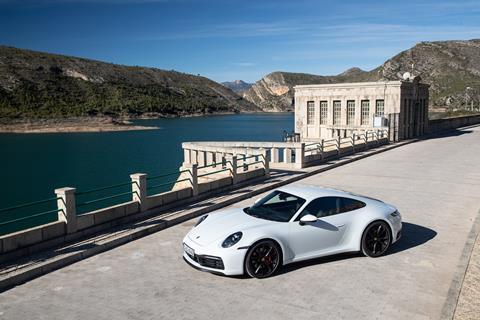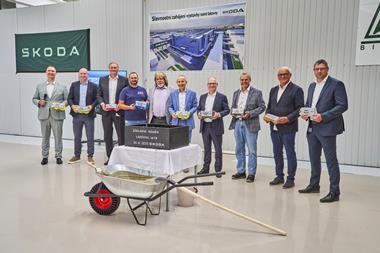The ongoing drive to reduce vehicle weight is seeing an increasing percentage of aluminium being used in car bodies. In the context of this lightweighting challenge, an ambitious joint effort by Chemetall and Porsche has achieved a targeted share of 80% aluminium throughput in a phosphating pre-treatment plant

Lightweight materials such as aluminium play an ever-greater role in modern vehicle manufacturing. Lower weight only has a positive effect on driving dynamic parameters, such as acceleration, driving stability and braking distance, it also reduces fuel consumption. This is a matter of increasing significance in view of dwindling resources and ever stricter emission limits. Moreover, the use of lightweight metals instead of conventional steels makes it possible to further adapt the weight distribution in the vehicle, and thus the driving dynamics, in the desired way. Porsche was quick to recognise the benefits of a higher percentage of aluminium in car bodies and has been utilising this material for many years.
However, a higher share of aluminium in the car body requires an increasingly complex paint pre-treatment, as aluminium places very different demands on corrosion pre-treatment compared to steel or galvanized steel. Here, the pre-treatment of lightweight multi-metal car bodies made from galvanized steel with a high share of aluminium is particularly challenging. Since the pre-treatment constitutes the essential basis for the subsequent painting steps, it’s vital to ensure that the requirements in terms of corrosion protection and paint adhesion are met.
“By shifting to an immersion pre-treatment of the parts, we achieved a further improved coating of the car body interiors along with energy savings of up to 20% as compared to the previously used method” – Christoph Warth, Porsche
The Surface Treatment global business unit of BASF’s Coatings division, operating under the Chemetall brand, is known for its innovative surface pre-treatment technologies and continuous process improvements. Chemetall identified the trend towards lightweight car body design early on and addressed it. GardoFlex, is a technology for the pre-treatment of multi-metal car bodies with a high percentage of aluminium content, that was introduced at Porsche. The goal was to achieve an efficient pre-treatment that affords maximum quality while at the same time reducing costs thanks to its multi-metal capability and shorter processing times for the user.
Customised pre-treatment – this is how the technology works
The possibility to treat different substrates in one line allows for flexible production without compromising quality. Robert Vengust, account manager at Chemetall, explains: “The GardoFlex technology offers modules that can be optimally adapted to the substrates to be treated.“
To put it simply, the entire process is based on a modified zinc phosphating technology. In the conventional, acid zinc phosphating process, all substrates are first pickled, a process during which a zinc phosphate coating is formed. So, while the iron and zinc ions from that process settle in the form of a phosphate sludge that can be removed by filtration, in a first step the aluminium ions have to be complexed with the help of additives. The resulting cryolite sludge is removed from the phosphating bath by filtration. This is necessary to avoid the aluminium ions dissolved in the phosphating bath, negatively impacting the formation of the phosphate coat and prevent the cathodic electropaint (CEP), applied in the next step, from separating with the required evenness and low roughness. In view of the growing share of aluminium in multi-metal car bodies, the even formation of a phosphate coat becomes a technical challenge.
Chemetall’s GardoFlex technology makes it possible to apply a continuous, homogeneous phosphate layer on all metal substrates of a car body and therefore also to pre-treat modern multi-metal car bodies with 80% aluminium content. This is achieved by optimally combining modern activation and phosphating technologies. As a result, coating formation on the metal substrate is accelerated in the phosphating bath and pickling loss is reduced. Significantly less sludge forms which in turn has a positive effect on maintenance and disposal costs. Also, the consumption of fluoride additives can be reduced by up to 40%. Vengust explains the benefits of this technology compared to conventional pre-treatment processes: “Thanks to the modern and more reactive activation components of the GardoFlex technology the pre-treatment process is very stable, irrespective of the substrate mix to be treated.”

The deposition of an even phosphate coating on aluminium substrates can smoothen out minor irregularities from previous process steps and thereby promotes an even deposition of the electrocoat. Also, activation bath cooling, as required by other technologies, is no longer necessary. As a result, and depending on the individual configuration of the plant, a higher throughput speed and thus a larger number of parts treated per shift or a reduced bath temperature can be achieved.
New pre-treatment for the new 911 series
With the market launch of the latest 911 series in 2018, this car body pre-treatment technology was introduced at Porsche for the new multi-metal mix car bodies featuring 80% aluminium content. “By shifting to an immersion pre-treatment of the parts, we achieved a further improved coating of the car body interiors along with energy savings of up to 20% as compared to the previously used method”, reports Christoph Warth, head of the Process Department Paint Shop Zuffenhausen at Porsche AG. Another benefit is that fewer incrustations form in the treatment tunnel and on the skids of the phosphating step, leading to significantly reduced maintenance work, on-time production processes as well as minimized plant downtimes.
This is where the modular structure of the GardoFlex technology demonstrates its clear benefits: The highly efficient activating agent Gardolene V6559 affords a uniform and stable deposition of a finely crystalline phosphate coat while a modern direct filtration unit removes the cryolite sludge from the phosphating bath.
“An additional advantage of GardoFlex is that the occurrence of defects that may result from car body manufacture, such as scrub marks of impressions from the vacuum cups of the robots, is largely eliminated after cathodic electropainting”, adds Vengust. Additional manual reworking, especially grinding work, is therefore no longer required. Vengust summarises: “A few months after the introduction we can now say that this state-of-the-art zinc phosphating technology perfectly fulfils the designated requirements.”
The result
Chemetall draws on its vast experience in the continuous development of new processes and pre-treatment technologies that have demonstrated their worth in its partnership with Porsche. These processes meet all requirements in terms of flexibility, modern production technologies and optimal pre-treatment. To perfectly prepare a smooth production workflow, Chemetall has the capability to simulate and test the pre-treatment processes of automotive customers in its state-of-the-art laboratories worldwide. For Chemetall, developing customised and aligned solutions for its customers is a top priority.
Overall, more than 80m vehicles treated with the GardoFlex technology are currently on the roads worldwide. Also, in the future, Chemetall’s customers can rely on the fact that the company is continuously developing new, innovative technologies to guarantee an optimally protecting pre-treatment. This also convinced Porsche. “Technologies that are reliable and optimally tuned to our products are essential for our commitment to quality”, says Warth.
Images courtesy of Porsche AG








































No comments yet